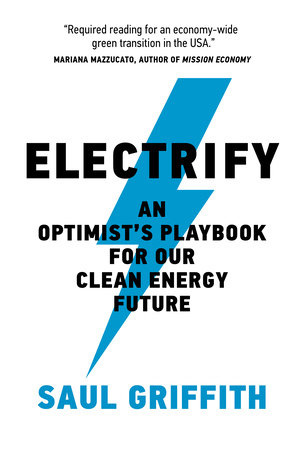How to Fix Climate Change (A Sneaky Policy Guide)

Climate change is a planetary emergency. We have to do something now — but what? Saul Griffith, an inventor and renewable electricity advocate (and a recipient of a MacArthur “genius” grant), has a plan. In his book “Electrify,” Griffith lays out a detailed blueprint for fighting climate change while creating millions of new jobs and a healthier environment. Griffith’s plan can be summed up simply: Electrify everything. He explains exactly what it would take to transform our infrastructure, update our grid, and adapt our households to make this possible. Billionaires may contemplate escaping our worn-out planet on a private rocket ship to Mars, but the rest of us, Griffith says, will stay and fight for the future.
“I want readers to be able to understand the main arguments of this book without getting stuck in too many details,” he writes in one of the book’s appendices, excerpted below. “Here, I will try to offer you dinner party-ready talking points for the main questions that people will inevitably have for the main argument of the book. Each topic is worthy of a book in itself. If I dispose of a favorite baby of yours too quickly here, or you think I have it all ass-backward, then we should grab a beer sometime.”
—The Editors
Yes, and . . . What about Carbon Sequestration?
Carbon sequestration would be a great technology to support, if only it were a good idea. It is attractive because it gives us the illusion we can just keep on burning fossil fuels if we can figure out how to suck the emissions back out of the air.
This idea derives from the natural processes that have kept our planet in balance for millions of years. Trees, plants, and microbes evolved to turn atmospheric CO₂ into a useful product — biomass or wood. They do so using cascades of elegant chemical reactions and enzymes. Plants create a large surface area in their leaves and branches, which allows them to do a great job of absorbing CO₂ from the atmosphere. All of the planet’s trees and grasses and other biological machines pull a grand total of about 2 gigatons (GT) of carbon a year. To put that in context, our fossil burning is emitting 40 GT a year. Imagining that we can build machines that work 20 times better than all of biology is a fantasy created by the fossil-fuel industry so they can keep on burning.

When considering carbon sequestration, we should first remind you just how staggering that 40 GT of CO₂ is. If you had a giant set of scales and put all the things humans make or move on one side, and all of the CO₂ we produce on the other, the CO₂ would weigh more.
The worst version of carbon sequestration is the most seductive one: capturing CO₂ from thin air. This is energetically difficult, and by that I mean as difficult as juggling babies, bowling balls, electric chainsaws, and flaming tiki torches. You have to sort through a million molecules to find the 400 that are carbon, then convince those 400 to become something they don’t naturally want to be: a liquid or, better yet, a solid. That sorting and conversion costs energy — a lot of it. Even if we could make it work reasonably, we’d have to install zero-carbon energy to run it, which is like using zero-carbon energy to supply our energy needs anyway, except it’s more complicated and expensive to add the carbon-sequestration step. The government should fund sequestration research, within reason and with some skepticism, understanding that it’s a miracle technology that we’d like to have but don’t technically need, and probably can’t afford.
The challenge of air capture is like a treasure hunt looking for CO₂ needles in the atmospheric haystack. You have to look at 2,500 molecules before you find 1 CO₂ molecule. For context, it is far easier to find Waldo, who in his various books appears at concentrations of around 1,200 to 4,500 PPM (or more accurately WPP, Waldos Per People).
More seriously, the paper on the topic that I think is the most informative is that by Kurt Zenz House and his colleagues. House analyzes carbon capture from chemistry-first principles and places a very high bar on anyone claiming to be able to sequester carbon dioxide from ambient air in a cost-effective manner. They project it would likely cost $1,000 per ton of CO₂; the most optimistic estimate is $300 per ton. Using the likely overly optimistic number, that would be the equivalent to adding 30¢/kWh to the cost of coal-fired electricity, or 15¢/kWh to the cost of natural gas. We should invest our time and money in things that are going to work instead.
A slightly better idea is capturing the highly concentrated CO₂ gas in a smokestack and somehow burying it. It is a little bit easier than the troubled idea of atmospheric CO₂ separations, because for some fossil fuels you can start with a concentrated flow of CO₂ in the smokestack, instead of a dilute gas that must be filtered from the atmosphere.
Sounds promising. But when we burn fossil fuels, we mix them with oxygen (that’s what combustion is), and in so doing the burned fuels become much larger (and also a gas which makes them larger still). The idea behind carbon sequestration of fossil fuels is basically to stuff the carbon back in the hole in the ground from whence it came. But even if you squeeze carbon dioxide back down into liquid form, which costs you yet more energy and money, the volume is much larger (around five times greater) than the volume that you originally took from the ground. That’s because when it came up it was mostly carbon, and when it goes back it is carbon with lots of oxygen. People propose putting carbon in other underground reservoirs, or at the bottom of the sea where the pressure of the water could contain it. But if you spring a leak, you lose all that hard work.
The economic argument against sequestration is that renewables are already competitive with coal and natural gas in most energy markets, and the added expense of carbon sequestration is not going to help fossil fuels compete. It is not unreasonable to say that the expense of carbon sequestration would be the death knell of fossil fuels.
Natural gas is an unsafe, collapsing bridge to nowhere. We burned that bridge . . . with natural gas.
Even though smokestack sequestration is a bad idea, the fossil-fuel industry is happy to have the American public confuse that bad idea with the worse idea of capturing the more diffuse emissions from cars, furnaces, or kitchen stoves. Those emissions are extremely distributed — they are generated at the furnace and stovetop ends of the 4.4 million miles of the U.S. natural-gas pipeline distribution network and our 260 million tailpipes. It is nearly unimaginably difficult to collect the CO₂ from those sources and render it into a form that doesn’t end up in the atmosphere.
In addition to the obvious business-as-usual reasons for the fossil industry to champion fossil fuels with carbon sequestration, the self-interest goes further. By injecting this CO₂ into the ground, the industry can force more fossil fuels back up; in fact, most of the CO₂ that humans have sequestered so far has been used to help with “enhanced” oil and fossil fuel recovery — further perpetuating our reliance on fossil fuel. This is an expensive, multi-layered cake of bad ideas topped with cynical frosting.
Frack ’em all.
Yes, and . . . What about Natural Gas?
Natural gas sounds benign, like the energy version of organic kale. But despite the “natural” label, it’s largely methane, mixed with ethane, propane, butanes, and pentanes. When natural gas burns, like other fossil fuels, it emits carbon dioxide, carbon monoxide, and other carbon, nitrogen, and sulfurous compounds into the atmosphere, contributing to the global greenhouse-gas effect and local air pollution. Don’t be fooled by those who will profit from confusion by promoting ideas like natural gas as a “bridge fuel” to the clean-energy future. Coal gets more air-time as a dirtier fuel, but natural gas is just as filthy if you account for the fugitive emissions. Natural gas is an unsafe, collapsing bridge to nowhere. We burned that bridge . . . with natural gas.
Yes, and . . . What about Fracking?
Fracking — or hydraulic fracturing — is the process of pumping pressurized liquid into well holes to fracture the surrounding rock, which enables gas and other hydrocarbons to be more readily extracted. This technology, and the accompanying revolution of horizontal drilling, gave the U.S. cheap natural gas at exactly the wrong moment in history.
Fracking spews methane directly from the mining sites, which offsets the nominal win from burning natural gas instead of coal. It also leaks from its network of distribution pipes. There are many other underlying problems with mining natural gas, such as water-table pollution and the creation of seismic instabilities. What’s more, it’s a huge distraction from the things that we know to be zero-carbon, like solar, wind, nuclear, pumped hydro, electric vehicles, and heat pumps.
Yes, and . . . What about Geoengineering?
We already are geoengineering, we are just doing it badly — we’re heating the earth and destroying the planet’s lungs. Burning fossil fuels is geoengineering that gives us climate change. The question is, can we geoengineer for good instead?
Geoengineering is not a decarbonization strategy. It is a hope to control the temperature of the earth while giving up on CO₂ strategy. Many of the early arguments for studying geoengineering were that we should know how to do it, just in case the world turns out to be apathetic about climate change. We now know of multiple paths to geoengineering to mitigate climate change: most of them amount to managing the incoming flux of energy from the sun. You have probably heard of these ideas — giant space mirrors, scattering reflective particles in the atmosphere, or artificially generated clouds. In an ecosystem as complex as that of earth, all of these ideas will produce unintended effects.
Geoengineering is a bit like using liposuction as the solution to obesity when you’re just going to keep eating cheeseburgers.
Embracing geoengineering would also make us forever dependent on future geoengineering solutions. It’s a bit like using liposuction as the solution to obesity when you’re just going to keep eating cheeseburgers. Even if it works, we can’t afford to lose sight of the better, cleaner solutions proposed in the rest of this book.
The problems of trying to control the climate are many. Who sets the temperature? Low-lying islanders and people who love coral or northern Europeans who might benefit from a bit more climate change? We don’t really know all of the unintended consequences — environmental, social, or political — that would arise from geoengineering.
It is a good idea to study geoengineering schemes, and it does help us understand earth systems better, but this is not a realistic or permanent solution. It could also draw large amounts of resources away from technologies we already know can solve the problem.
Yes, and . . . What about Hydrogen?
Many people believe hydrogen will provide a pathway to decarbonization. But hydrogen is not a source of energy. You don’t discover hydrogen; it is a battery in the form of a gaseous fuel. The fossil-fuel industry is happy to promote the hydrogen fiction because the majority of hydrogen sold today is actually a byproduct of the natural-gas industry. Only a tiny amount of gaseous hydrogen exists naturally on earth. To make and store carbon-free hydrogen, we would first have to create electricity to power a chemical process called electrolysis, which is not highly efficient. Then we’d have to capture the hydrogen gas and compress it, which consumes about 10–15 percent more energy. Then we’d have to decompress the gas and burn it or put it through a fuel cell. We lose more energy at every step of this process.
As a battery, hydrogen is pretty ordinary; for the one unit of electricity you put in at the beginning, you probably get less than 50 percent out at the other side. This is called “round-trip efficiency.” To run the world off hydrogen, we’d have to produce twice the amount of electricity that we currently produce, which would itself be a monumental challenge. Remember, chemical batteries typically have 95 percent or so round-trip efficiency.
Germany and Japan invested heavily in hydrogen because they don’t have domestic natural gas and they wanted something with the energy density of gasoline. In theory, hydrogen has about three times more energy per kilogram than gasoline (123 MJ/kg as compared to 44). But you have to compress it and store it in a tank made of exotic materials. The tank weighs much more than the hydrogen gas itself. If you include the tank in your calculations, hydrogen ends up being about a quarter of the energy density of gasoline and only a little more energy dense than batteries.
I started a company called Volute that built better compressed natural gas and hydrogen tanks. This technology is now licensed into both of those industries, so even as someone who would profit greatly from a hydrogen economy, I’m pretty confident it will only end up being a niche player. We can argue about the size of the niche. For example, hydrogen can serve as the high-temperature gas for industrial processes such as steelmaking and can solve some transportation problems.
Hydrogen will be useful, but it is not the answer.
Yes, and . . . What about a Carbon Tax?
A carbon tax isn’t a solution. A carbon tax is a market fix meant to make all of the other solutions more competitive. It’s designed to slowly increase the price of carbon dioxide, making fossil fuels uncompetitive. The idea is that a high enough carbon tax would make all of the fossil fuels more expensive than at least some of the other solutions, and then a perfectly rational market would use those cheaper clean-energy solutions.
Carbon taxes might have been sufficient if we’d started with them in the 1990s, but for the taxes to achieve the 100 percent adoption rates we need now, they would have to ramp up very quickly. They would also be difficult to implement, as well as regressive, hitting lower-income people hardest.
A carbon tax isn’t a solution. A carbon tax is a market fix meant to make all of the other solutions more competitive.
It would probably be just as effective to eliminate fossil-fuel subsidies, which in many markets would tip the scales in favor of alternatives anyway. And by the time we have the political will to implement a carbon tax, renewables with batteries will be cheaper than fossil fuels.
A carbon tax is useful in decarbonizing the hard-to-reach end points of the material and industrial economy, but unlikely to be rapid enough to transition home heating to heat pumps, and vehicles from internal combustion engines to electric vehicles at the rate required.
Yes, and . . . What about Technological Miracles?
“Miracle” technologies include fusion, next-generation nuclear fission, direct solar rectification, airborne wind energy, high-efficiency thermoelectric materials, ultra-high-density batteries, and other technological breakthroughs we can’t yet imagine. All of these miracle technologies would, in fact, help with various components of decarbonization, and the U.S. should invest in them as research topics. With good management, some of them might come to fruition. However, it would be unwise to bet our future on miracles, as our timeline for climate-change solutions is too short. Any ambitious technology like these would take decades to develop and scale up. We don’t have decades.
The real miracles are that solar and wind are now the cheapest energy sources, electric cars are better than vehicles with internal combustion engines, electric radiant heating is cozier than our existing heating systems, and the internet was a practice run and blueprint for the electricity network of the future.
Yes, and . . . What about the Existing Utilities?
There is no way we win this war without the utilities. We need them to deliver three to four times the amount of electricity they do today. They are perfectly poised to be a giant participant in our clean-energy future.
Utilities should be the natural leaders in this project, as they already have five valuable characteristics (thanks to Hal Harvey for pointing this out): 100 percent market penetration, 100 percent billing efficacy, 100 percent knowledge of how we use electricity today (if they want to know it), access to low-cost capital, and an incredible local workforce in every zip code.
Beware the utility that prioritizes its natural gas business over its electricity business. If you really want to make a difference, get yourself elected to the board of your state’s utility commission and steer it in the right direction.
Yes, and . . . What about Emissions That Are Not Energy-Related?
“Electrify” principally concerns itself with the approximately 85 percent of greenhouse-gas emissions related to the U.S. energy system. They are the overwhelming majority of our emissions. The other emissions come from the agricultural sector, land use and forestry, and from industrial non-energy-use emissions. If we undertook the mobilization to address climate change as suggested in this book, this would also address much of the industrial non-energy emissions and a little of the other two, as well. Decarbonizing our energy supply is 85 percent of what we need to do. For the other 15 percent, people are successfully making and selling synthetic meats, creating pathways to cooling without terrible refrigerant emissions, and working on steel production with hydrogen and aluminum without CO₂. I have to believe that if we commit to the 85 percent, the smart and passionate people working on the other 15 percent will do their part, too.
Yes, and . . . What about Agriculture?
The moonshot to ignite the heartland’s creativity is replacing a harmful monoculture system with an agriculture that sequesters carbon and heals our soils while also preventing the pesticide and fertilizer run-off that is polluting our rivers, estuaries, and oceans. Our world-class system of land-grant universities should be able to knock this out of the park.
Yes, and . . . What about Meat?
There are a number of problems with meat, as any vegan will tell you. One is the amount of land required to grow the animal feed. Another is that ruminants such as cows and sheep belch methane, which is far worse as a greenhouse gas than CO₂. Eating less meat remains one of the easiest consumer decisions to reduce climate impact, but it alone cannot solve our climate problem. On an infrastructure scale, better land management and new low-carbon farming alternatives will lower the impact of occasional meat consumption. My old friend David MacKay used to quip that the best way to harness solar energy in Scotland was to grow and eat sheep. Meat-eating doesn’t have to go away completely, but Americans do need to become more conscious about their diets.
Yes, and . . . What about Zero-Energy Buildings?
Building standards for extremely efficient homes that need no net-energy input, such as the energy-efficient German “passivhaus,” are a good idea. Exactly what constitutes “no net-energy input” is up for debate because of the complexities of tracing material and energy flows. Some will argue that with a sufficiently good passivhaus you do not need heat-pump heating; that may be true, but we have to solve this problem for the houses that are already built as well as the houses we build tomorrow — in the U.S. only 1 percent of our housing stock is built new each year.
These houses, no matter how they are built, will be rare birds. Remember, too, that only about 2 percent of houses are built by an architect; the majority are built from common plans by a contractor. I think of passivhaus and other similar architectural plans as a wonderful library of very good ideas for building efficient houses, and even some retrofits, and we all, especially architects and builders, should embrace these ideas and create even more.
What would perhaps have more impact in this area are the cultural shifts that make living in smaller, simpler houses more desirable. Mobile homes have gotten a bad cultural rap, but they have a smaller carbon footprint than conventional houses and could offer one of the fastest pathways for adopting modern decarbonized domestic infrastructure.
Yes, and . . . What about the Rest of the World?
America is only responsible for about 20 percent of current annual global emissions (though historically, it has produced a larger share). People say this is why it’s not worth bothering with decarbonizing the U.S. China will emit more, and if not them, it will be the Saudis, or India, or Africa. If we all adopt that defeatist attitude, we are done. If America leads, however, it is likely that other countries will follow once they see the economic advantages of doing so. The early movers will own the lion’s share of these critical 21st-century industries.
Yes, and . . . Can We Make Enough Batteries?
No two ways about it, we will need a lot of batteries. This is not impossible, though, given America’s current manufacturing capacity. To replace our 250 million personal gasoline-powered vehicles with electric vehicles in the next 20 years, we will need over a trillion batteries, or around 60 billion 18650 batteries every year (18650’s are 18 millimeters in diameter and 65 millimeters long — slightly larger than your flashlight’s AA batteries). That is similar to the 90 billion bullets manufactured globally today. We need batteries, not bullets.
Yes, and . . . What about Flying?
Flying is energy-intensive per minute, but not per mile. Per passenger-mile traveled, it requires approximately the same energy as driving in a car with a passenger. That said, reducing the number of flights taken is one of the most effective ways for individuals to reduce their energy footprints.
In the electrified future, short-haul flights (under 500 miles) will be electric, enabled by increases in the power density of motors and batteries. Long-haul flights will use biofuels to get enough range. Passenger and freight flights in the U.S. require a total of 2 quads, and military aviation is another 0.5 quads. The U.S. can produce about 10 quads of biofuel energy, easily covering the tab for flying, in addition to other hard-to-electrify things like construction and mining equipment (which together add another 1–2 quads).
I have several friends who have electric aircraft companies; they are very bullish on flying cars. I have another colleague who accurately states that at about 80 mph it starts to take more energy to keep the car on the ground than just flying it — keeping the car’s tires on the ground costs you a lot in energy! It is even possible to convince yourself that small electric aircraft will have energy efficiencies per passenger mile similar to electric cars. This is true if you fly naked, but not if you pack a lot of luggage. Also, if we could all fly everywhere quickly, we’d do it more, and lose the gains in extra miles traveled. As a result, I predict this will remain the domain of billionaires.
Yes, and . . . What about Autonomous Cars?
Like flying cars, autonomous cars have captured the public’s imagination (not to mention the self-interested parties trying to profit from them). Supposedly, they will reduce traffic and lower emissions. This is almost certainly not true. When groups of people were given a chauffeur as a stand-in for an autonomous vehicle, they drove many more trips, and would occasionally send the “autonomous” car across town to buy them their favorite sandwich. Autonomous cars will almost certainly induce more miles traveled.
Even if we all are driven around to the same places, we’ll increase miles driven by 40 percent. Honestly, this is yet more Silicon Valley snake oil.
In the taxi industry, there is something known as “carriage-miles.” This is the ratio of miles driven without a passenger to miles driven with one. For taxis, this ratio is about 1.7, meaning the car has to drive 1.7 miles to move a passenger 1 mile. In disrupting the taxi industry, Uber and Lyft were able to get this number down to about 1.4. This is probably a good proxy for what will happen with wide deployment of autonomous vehicles. Even if we all are driven around to the same places, we’ll increase miles driven by 40 percent. Honestly, this is yet more Silicon Valley snake oil.
Yes, and . . . What about the Dangers of Nuclear Power?
America has led the world in nuclear power. The U.S. Navy operates the largest fleet of small reactors in the world, and it boasts an impeccable safety record. Nuclear is a form of electrification, and it fits squarely with the plan to fight global heating. Nuclear power currently delivers around 100 gigawatts of very reliable electricity to America’s grid. Maintaining or even ambitiously increasing this amount would no doubt make the climate solution easier. Today’s best estimates have nuclear energy at approximately double the cost of wind and solar. Without a doubt, those costs could be trimmed enormously given advances in engineering, since most of these plants were designed 50 years ago.
The health effects of nuclear power have been well studied. It is established that nuclear is not as dangerous as we tend to think. But like shark attacks, it’s the prospect of a low-probability event that could release radiation that drives our fears. We can lower that probability further by building dedicated infrastructure like the facility at Yucca Mountain, but the fact remains that for 40 years, policymakers haven’t been sufficiently able to convince people to invest in this kind of infrastructure. Nuclear power will remain a very difficult political topic unless we have a breakthrough in waste management.
Yes, and . . . What about Growing Trees?
Yes, we should — at least a trillion. Grab a shovel!
The best time to plant a tree is 30 years ago. The second-best time to plant a tree is today.
Go plant a tree for your grandkids to climb on. Even better, go plant 30,000.
Saul Griffith, inventor, entrepreneur, and engineer, is founder of Rewiring America, a nonprofit dedicated to decarbonizing America by electrifying everything, and founder and chief scientist at Otherlab. He was a recipient of a MacArthur “genius grant” in 2007. He is the author of “Electrify,” from which this article is excerpted.



